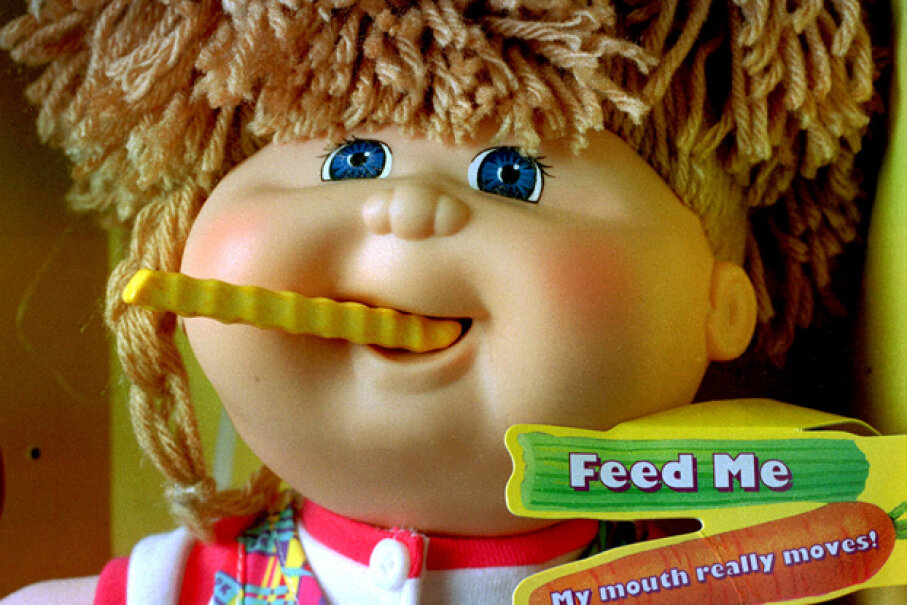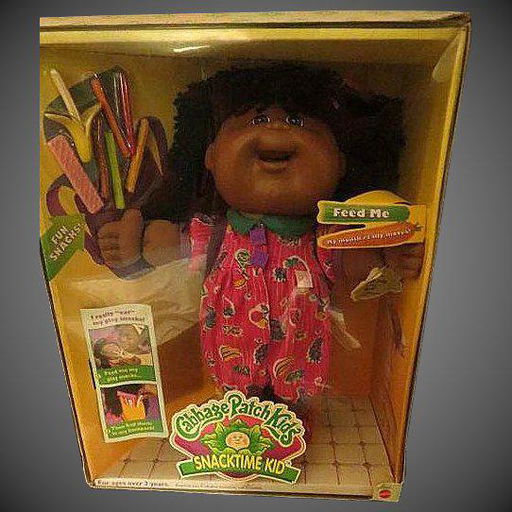2020. 3. 18. 22:16ㆍ카테고리 없음
The listing, THIS IS THE HOLY GRAIL CABBAGE PATCH KIDS SNACKTIME DOLL BRAND NEW IN THE BOX VERY RARE has ended.This is One of the Holy Grail Cabbage Patch Snacktime doll this is brand new in the box and is very very rare. Her name is Jerilyn beth and was born in the Cabbage Patch on October 1. If you are Cabbage Patch collector then this is a must-have item for your collection these doll is the holy grail of cabbage dolls only lasted a very short time on the shelves. This is from the 1990's. The box has some normal wear and some very little tear due to its age for being rare and vintage I am sure you will not come across another one of these for a very long time so you should snag it while you can especially it being brand new in the box.
Any questions or comments just ask. I will be listing more Cabbage Patch Kids items shortly so don't forget to check back.
Cabbage Patch KidsTypeCompany(1982–1988)(1988–1994)(1994–2003)(2003)(2004–2011)(2011–2014)(2015–present)CountryAvailability1978–presentCabbage Patch Kids are a line of dolls sold by and registered in the United States copyright office in 1978 as 'The Little People'. The brand was renamed 'Cabbage Patch Kids' when the dolls went into mass production in 1982. The dolls were based upon a design originally created by.The doll brand was one of the most popular toy of the 1980s and one of the longest-running doll franchises in the United States. The characters appeared in many other Cabbage Patch merchandising products ranging from animated cartoons to record albums to board games. Contents.Production history Creation and development According to Roberts, as a 21-year-old art student, he utilized the quilting skills he learned from his mother and the historic technique of 'needle molding' to develop his own line of fabric sculptures.
He called these hand-stitched, one-of-a-kind, soft fabric sculptures 'The Little People'. (Other soft sculpture dolls dating back to the 19th century were created using similar needle molding techniques.) His Little People were not offered for sale, but were 'adopted' each with their own individual name and birth certificate. Instead of paying a purchase price, buyers of Little People would have to pay an adoption fee.The Little People were first sold at arts and crafts shows, then later at, an old medical clinic that Roberts and his friends-turned-employees converted into a toy store, in.An early transaction at Babyland General Hospital worth noting is the sale of the only Little People quintuplets ever made at the facility. Bennie and Jeannie Shelton of Cumming, Georgia paid $5,000 to buy the one-of-a-kind set of five identical dolls. Also worth noting is one of Roberts' very first Little People dolls he ever created sold at an auction in Virginia in the early 1980s for $3,000.According to the discovery legend Roberts came up with for his Little People, and later reproduced on every Cabbage Patch Kids product from 1983 onward:Xavier Roberts was a ten-year-old boy who discovered the Cabbage Patch Kids by following a BunnyBee behind a waterfall into a magical Cabbage Patch, where he found the Cabbage Patch babies being born. To help them find good homes he built BabyLand General in Cleveland, Georgia where the Cabbage Patch Kids could live and play until they were adopted.
BunnyBees are bee-like creatures with rabbit ears they use as wings. They pollinate cabbages with their magic crystals to make Cabbage Patch babies. Colonel Casey is a large stork who oversees Babyland General Hospital. He's the narrator of the Cabbage Patch Kids' story. Otis Lee is the leader of the gang of Cabbage Patch Kids that befriended Xavier. Coleco years The name change to Cabbage Patch Kids was made in 1982 when Xavier's company, Original Appalachian Artworks, began to license a smaller version of the handmade creations to a toy manufacturer named which began mass production the same year.
The Coleco Cabbage Patch Kids had large, round heads (originally of a different, hard plastic), and soft fabric bodies, and were produced from 1982 to 1989, many at a factory in. The first two years production was all from the Far East, with nine head variations produced and computer-matched with bodies to ensure each doll was 'different'. It was, in fact, a marketing ploy that worked quite well as a wide range of variations resulted.
(Source: Larry Moniz, then senior account supervisor for the Coleco account at Richard Weiner Public Relations in NYC.)At the peak of their popularity, the dolls were a must-have for. Parents across the flocked to stores to try to obtain one of the Cabbage Patch Kids for their children, with fights occasionally erupting between parents over the hard-to-find dolls. See also: Lawsuits Though Xavier Roberts was the creator of the Cabbage Patch Kids brand, many of the brand's defining characteristics — such as the dolls' overly round faces and that they came with an certificate — were taken from, an American folk artist from. Before Roberts became involved in the toy industry, Thomas had created and marketed her own line of dolls, called Doll Babies, which she sold at local arts and craft shows and markets. The two crossed paths at a state fair in 1976, whereupon Roberts began purchasing Thomas' dolls to sell at a profit at his own store in Georgia. Thomas eventually confronted Roberts about his unethical business practices and ceased to sell additional dolls to him, prompting him to turn to a manufacturing company in to mass produce dolls similar in appearance to Thomas' at a cheaper cost to him. Thomas brought suit against Roberts and eventually settled with him out of court for an undisclosed amount in 1985.
She and her husband, Tucker Thomas, told the press that she was more upset by the corruption of her dolls, for which she cared deeply, than the money she'd lost as the result of Roberts' actions. Thomas died in 2013, at the age of 62, with her most favorite dolls attending her funeral alongside her family members and friends.Xavier Roberts himself later brought a $30 million lawsuit against, the company that produced grotesque trading cards parodying his company's dolls called the, for copyright infringement. In 1987, in the midst of the legal proceedings, the makers of the Garbage Pail Kids announced their decision to cease the Cabbage Patch Kids, to which Roberts commented to the press 'I could scream, I'm so excited.'
Product safety One line of Cabbage Patch Kids dolls, the Cabbage Patch Snacktime Kids, was designed to 'eat' plastic snacks. The mechanism enabling this was a pair of one-way smooth metal rollers behind plastic lips.
The snacks would exit the doll's back and 'magically' appear into a backpack. The mechanism could be de-activated by releasing the backpack. They were extremely popular during Christmas 1996. The line was voluntarily withdrawn from the market following an agreement between Mattel and the in January 1997 following several incidents where children got their fingers or hair stuck in the dolls' mouths leading to safety warnings from Connecticut's commissioner, Mark Shiffrin. Timeline.
1977: Xavier Roberts is introduced to ' 'Doll Babies' concept. 1978: The first 'Little People Originals' were delivered by Xavier Roberts, who incorporated Original Appalachian Artworks, Inc. 1981: There was coverage of the dolls' popularity in, and Atlanta Weekly. 1982: Original Appalachian Artworks, Inc.
Signed a long term licensing agreement with Industries to produce the dolls in August 1982. 1983: Cabbage Patch Kids were introduced with great fanfare at the International Toy Fair in NYC. By October, in stores around the country. The dolls made the cover of Newsweek before and stories of their success were heralded around the world. 1984: Sales for Cabbage Patch Kids branded products, from toys to children's apparel, came close to the record setting $2 billion mark.
The CPK record, titled, produced by the Chapin Brothers for Parker Brothers' music, went. The video game was released. 1985: Cabbage Patch Kids low-sugar and real children's character art were introduced. The Cabbage Patch Kids' First Christmas was number one in its time slot on ABC. 1986: The first talking Cabbage Patch Kids were released. 1988: Coleco Industries filed for bankruptcy, but the dolls continued to be made, with the licensing rights being granted to and later to.
1992: Cabbage Patch Kids were named the official of the 1992 U.S. Team and members of the team were given their own dolls to take to the games. 1996: The Cabbage Patch Snacktime Kids were released.
1999: By popular vote, the dolls were selected as one of the 15 US representing the 1980s. They were voted fifth behind, Washington's Vietnam Veterans Memorial, the end of the Berlin Wall and video games. 2008: and had their own Cabbage Patch Kids. Was depicted with a blue suit. Was depicted in a suit with grey hair. Was also depicted in a suit with his hair slicked up. Was depicted in a trademark suit and skirt with high heeled pumps.
Also, Palin's signature hair and eyeglasses were featured.See also.References. Retrieved 2010-03-03.
Babyland General Hospital. Archived from on February 18, 2008. Retrieved February 22, 2008. Retrieved 2010-08-07. DeMott, John S.; Bureaus, Other; Byrnes, Rosemary (1984-12-10). Retrieved 2010-03-03. Retrieved 2010-03-03.
Retrieved 2016-03-19. Retrieved 2013-11-12.
Retrieved 2016-03-19. Susan Gunelius. Retrieved August 31, 2016. 'The Secret History of Cabbage Patch Dolls' May 10, 2015 Vice. Piro, Lauren.' The Not-So-Sweet Truth About Cabbage Patch Kids: Behind those iconic chubby cheeks is a disappointing story' Apr 21, 2015.
Good Housekeeping. 'Baby Snatcher: He Stole Her 'Doll Baby' Concept To Make Iconic Cabbage Patch Kids' Apr 20, 2015.
Women You Should Know. 2017-12-12 at the. Good Housekeeping. Retrieved 2018-04-11. ^ Joyce, Fay S.


'CABBAGE PATCH KIDS SPUR A BATTLE OVER PARENTAGE' December 6, 1983. New York Times. Original Appalachian Artworks v.
Toy Loft, 489 F. District Court for the Northern District of Georgia - 489 F. 1980)May 2, 1980. Retrieved 2018-04-11. Retrieved 2010-03-03. The New York Times. Retrieved 2010-08-07.

Retrieved 2018-04-11. The New York Times. Retrieved 2010-08-07. United States. Archived from on 2008-02-20. Retrieved February 22, 2008.
April 14, 1999. Archived from on May 4, 2018. Retrieved November 5, 2016 – via. (Subscription required.). Archived from on 2010-04-23. Retrieved 2010-04-23.Further reading. Hoffman, William (1984).
Vintage Cabbage Patch Dolls For Sale
Dallas: Taylor Publishing.External links.